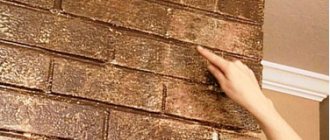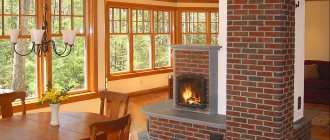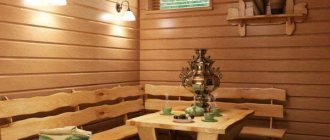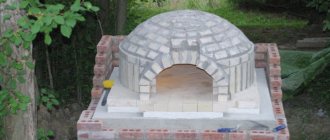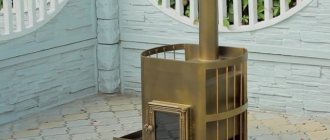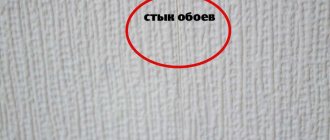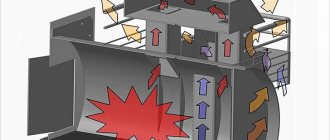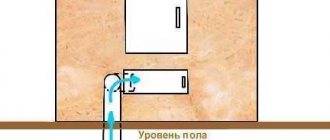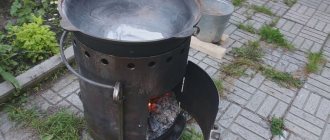Coloring instructions
Having learned how to paint the stove in the bathhouse, you can purchase paint and prepare the stove for painting.
Tools and materials
To do the work yourself you will need:
- paint, preferably in aerosol cans;
- if you use liquid paint in cans, you will need to purchase a roller and brush;
- sandpaper to remove a layer of rust;
- metal brush;
- when cleaning large areas, use a grinder;
- solvent for degreasing parts;
- for painting you can use a spray gun and a compressor, especially with large dimensions of the structure;
- rags;
- paper or old sheets to protect the surface of walls and floors when painting.
Having dealt with the question of how to paint an iron stove in a bathhouse and having prepared the materials necessary for the work, you can begin to carry out the preparatory work.
Surface preparation
To do this you will need to perform a number of simple works. But surface preparation must be approached with full responsibility; this determines how the paint will adhere to the metal and how long its layer will withstand high temperatures:
- Using a metal brush, we clean the stove from adhering dirt, soot and rust;
- Clean the finished surfaces with fine sandpaper. This work will make the surface smooth, remove minor scratches and irregularities;
- sweep and remove dust from the stove parts;
- Having generously moistened a rag with solvent, degrease all surfaces;
- If the stove has parts made of stainless steel or those that have undergone galvanic treatment, there is no need to paint them. Therefore, we will apply a layer of grease or other lubricant to the parts;
- cover the surface of the floor and walls next to the heater, paper or cloth.
Paint application algorithm
We know how to paint an iron stove in a bathhouse, the necessary preparatory operations have been completed, now you can move on to the main stage of work. This will not require much time and effort. All work is carried out in the following sequence;
- open and stir the paint well. If it is thick, it can be diluted with a solvent suitable for this enamel. Be sure to read the instructions and dilute the paint only with the specified mixtures. Otherwise, you'll just throw away a can of expensive paint;
- if a spray gun is used to apply the layer, the paint is diluted to a more liquid state, then poured into the spray gun through a painting sieve or the wife’s old tights;
- first apply a layer to all inconvenient places and edges of the oven and only then treat the surfaces, slightly overlapping the previous layer. When painting with a brush, the work is done in the same way;
- The paint is applied in 1 layer, so do not allow any gaps, painting all surfaces evenly.
Work is done. Now leave the oven until the enamel has completely hardened.
It is important to close all doors and windows to prevent dust from entering the room. For some paints you will need to light the oven; they only harden when heated.
Therefore, carefully read the instructions and strictly follow these rules.
How often should I paint in the future?
Paint for an iron sauna stove will last for the period specified by the manufacturer
You need to pay attention to this characteristic when purchasing enamel.
Expert opinion Pavel Kruglov Stove maker with 25 years of experience
The minimum period for high-quality surface coating for most manufacturers is 3 years
But the frequency of use of the stove and its operating conditions are of no small importance. In any case, if the stove is made of thin metal, it may fail before the paint coating of the surfaces
Paint is a short-lived coating, so every bathhouse owner should be prepared for repeated work to protect the stove
In any case, if the stove is made of thin metal, it may fail before the paint coating of the surfaces. Paint is a short-lived coating, so every bathhouse owner should be prepared for repeated work to protect the stove.
Is it possible to achieve a durable protective layer on the surfaces of the heater? Yes, in this case, performing a simple galvanic method of protecting the metal will help.
Coating instructions
The main disadvantage of metal is that when exposed to moisture for a long time, it begins to rust, gradually deteriorating. This process proceeds faster if the material is subjected to constant heating.
The purpose of the paint composition is to protect metal surfaces from rust and overheating. Sheets of metal look ugly compared to the exterior decoration of bathhouses. Enamel can be used to improve the appearance of equipment.
After selecting the coloring composition, you can begin work. To do this, you need to collect tools, prepare a metal surface, and perform actions following the technology.
Before painting work, you need to prepare consumables and tools:
- solvent for degreasing metal surfaces;
- metal cleaning brush;
- sandpaper
- coloring composition - it is better to choose products in aerosol cans;
- a grinder for cleaning large metal sheets;
- rags;
- roller, brush, if the paint is spilled into cans;
- plastic film to cover other surfaces.
If you need to paint a large area, you can use a spray gun with a compressor.
Paint brushes
Do not apply enamel to an unprepared surface. Before this you need to perform several steps:
- Use a brush to clean the metal from dirt and deposits;
- You can remove scratches, bumps, and rust using fine sandpaper;
- sweep away any dust with a broom;
- moisten a rag in solvent and degrease metal surfaces.
After completing the preparation, you need to cover the walls, floor and ceiling adjacent to the stove with plastic wrap.
When the paint has been purchased and the metal preparation has been completed, the main work can begin. Painting stages:
- Open the paint and stir thoroughly using a wooden or plastic stick. If the coloring composition is too thick, it can be diluted with a solvent. The packaging indicates a substance that can be used to dilute the paint. If you do not take this information into account, you can ruin the paint composition.
- Using a brush, paint over awkward places and go along the edges. After this, paint over the main surfaces with a roller. It is important to control the uniformity of the layer application and not leave any empty spaces.
After applying the paint, you need to close all rooms and windows. For some paints and varnishes, you need to heat the oven, since they only harden when heated.
Kindling the stove
Many people do not know how long to wait until the protective coating is completely dry. This parameter depends on the type of paint. Information about complete drying is indicated by the manufacturer on the packaging of the paint and varnish composition. The average period of time required for the decorative layer to completely harden is 72–96 hours. If you heat the oven before this time period has expired, exposure to high temperatures will lead to the destruction of the decorative layer.
We suggest you familiarize yourself with what kind of firewood is best for a stove in a bathhouse and what kind of wood should not be used to burn a stove
The packaging of the coloring composition indicates the warranty period for maintaining the integrity of the decorative coating. Stoves made of thin sheet steel can collapse faster than the paint layer can come off. If the furnace equipment has thick walls, you need to prepare to replace the protective coating.
How to coat
In order for enamel or paint to stick well and for a long time on the metal surface of the stove, it is not enough to choose the appropriate composition. It is necessary to strictly adhere to the technology when applying it. All the necessary information is on the packaging, but the principle is the same for any product.
Surface cleaning
Dust, dirt, rust, old coating and any other layers will not allow the paint to adhere well to the surface and adhere to it. They need to be removed.
- First, they use a metal brush to remove obvious contaminants and loose rust.
- Then the surface is brought to a shine with a drill with abrasive attachments or sandpaper.
Cleaning metal from rustSource yandex.net
- The next step is to remove dust using a soft broom or vacuum cleaner and damp wiping.
- The dried metal is degreased using a solvent recommended by the manufacturer. If there is no such recommendation, you can use white spirit or solvent P 646.
Solvent 646 does not cause metal corrosionSource artikaluga.ru
Painting
The coating is applied to the prepared surface immediately after it has dried, so that dust does not have time to settle on it. The painting method depends on the type of paint. If it is an aerosol can, it is advisable to cover all surfaces adjacent to the stove with a rag or film, and use a protective mask when working. Before starting staining, shake the can vigorously for 1-2 minutes.
Before painting a metal stove with regular paint, it must be thoroughly mixed and, if necessary, diluted with the product specified in the instructions. Other products may be incompatible with your paint and will ruin it.
The dyeing process itself is standard.
- The coating is applied evenly, without gaps.
- Before applying the second layer, you need to allow time for the first to set.
- The second layer should overlap the previous one in the transverse direction.
Painting with a spray gunSource bget.ru
The instructions may also contain special recommendations. For example, some silicone enamels acquire the required strength only when heated, so the oven must be melted immediately after painting. Other compositions require several hours or even days to dry normally, during which time the oven cannot be used.
But almost all enamels emit an odor when heated during the first time after application. Therefore, it is recommended that a freshly painted stove be heated 2-3 times thoroughly so that all volatile substances evaporate.
While the paint is drying, it is advisable to protect the oven from moisture and dust, so it is better to do painting work indoors. If this is not possible, you should choose a cool day without precipitation or wind.
After painting, even homemade stoves look very decent Source 24aul.ru
If everything is done correctly, the coating will last no less than the warranty period stated by the manufacturer
It ranges from 3 to 15 years, and you also need to pay attention to this parameter when choosing enamel
Preparing the surface for painting
- Traces of old coatings, soot, oil, and other contaminants .
- Rust is removed using sandpaper or sandblasting , then the surface of the stove is thoroughly washed and dried.
- Before painting the surface, it is treated with a degreaser , after which it is necessary to apply paint to the stove within 24 hours if the work is carried out indoors.
Video description
There are other ways to give a stove made of cast iron or ferrous metal a noble look. An example of such a transformation using a cheap folk method is shown in the video:
If you are deciding what paint to paint an iron sauna stove, then you need to choose compounds that are resistant to high and low temperatures and high air humidity. And also those that will not release toxic substances during bath procedures. Silicone enamels best meet these requirements. They cost more than other heat-resistant paints, but they also last longer. However, the service life directly depends on the quality of surface preparation and adherence to coating technology.
Requirements for paints for iron sauna stoves
The choice of paint depends on what material was used to make the stove. There are a number of general requirements - for example, you can only take compounds that can withstand high temperatures. But if a metal stove is installed in the bathhouse, then the paint should be such as to protect the material from corrosion.
The purpose of paint is to prevent traces of corrosion from appearing on the surface.
When buying paint, it is important to remember that negative factors affect a sauna stove:
- high humidity;
- steam, which affects the condition of the outer surface;
- high temperatures inside;
- temperature changes outside.
Even taking into account the fact that it is not a cast iron stove that needs to be painted, but a surface made of high-quality stainless steel, not all mixtures are suitable for this. They have to:
- be resistant to temperature changes;
- provide a high level of corrosion protection;
- comply with environmental standards;
- have water-repellent properties.
Heat resistance
The manufacturer attaches a certificate to each paint. It indicates the maximum possible temperature that the paint coating can withstand without damage (that is, without the formation of swelling and bubbles, cracking and similar troubles). This is the heat resistance of the product.
Standard interior mixtures can only withstand temperatures up to 80°C, so they are not suitable for baths where the metal is heated to 200°C. But not all heat-resistant paints perform well in such conditions.
To paint the stove, you must use only heat-resistant material.
For example, acrylic compositions can withstand up to 120°C, a short-term jump to 150°C, but in stoves with higher heating temperatures for a long time the use of such materials is problematic. Therefore, they are used as standard for central heating radiators. You need to look for paint that says it is intended for stoves and fireplaces.
Metal corrosion protection
The paint must protect against corrosion.
Due to the difference in temperature, condensation forms. If the metal is exposed to it frequently, rust will appear on the surface. So the paint for the stove should protect against corrosion, withstand the expansion of metal when heated and increase the service life of the device. You need to inquire about the protective characteristics before purchasing.
Water repellent properties
When choosing a mixture, the ability of the paint layer to repel moisture plays a role. For a bathhouse, this characteristic is important, since the air humidity here is high, which leads to the destruction of the metal.
Composition safety
Stove paint should not contain toxic substances. When the surface heats up, some compounds begin to accelerate. And in hot, humid air, when the pores of the skin and blood vessels expand, a person reflexively takes breaths - these harmful substances can enter the body in large quantities, causing poisoning. Therefore, only safe mixtures are used here.
What is used today?
Times have changed and no one cooks whitewash today. Modern owners of Russian stoves and fireplaces prefer other means. Let's look at each option in more detail.
Natural drying oil
Natural drying oil is used as stove paint - this coating does not change the color of building materials, but slightly changes the shade to a darker side.
Organosilicon paint
Along with drying oil, silicone paints are widely used for brick stoves. These compositions have many advantages:
- high adhesion to any materials;
- coating strength;
- resistance to moisture;
- high durability;
- heat resistance (withstands more than 200 cycles of temperature changes).
Alkyd based varnish
PF-283 varnish is also often used for painting fireplaces. It is a mixture that includes alkyd resins, modified vegetable oils, fatty acids and other additives. The varnish is mixed with turpentines in equal proportions. This increases the durability of the coating. After drying, a glossy transparent and very durable layer is formed on the surface.
Heat resistant paint
The most popular option is the use of heat-resistant paints for stoves and fireplaces. The material has a huge number of advantages:
- large range of colors;
- this is a heat-resistant paint - it can withstand temperatures up to 600 degrees;
- the surface of brick stoves and fireplaces is reliably protected from oxidation;
- the material has increased strength and wear resistance characteristics;
- performance qualities are maintained for more than 10 years.
Heat-resistant paint also has disadvantages, among which we especially need to highlight its aggressive composition, unpleasant odors, and long drying time.
Due to the presence of toxic substances in the composition, you should be careful when working with thermal paint
In the video: DIY heat-resistant paint.
Painting procedure
Now you can start painting the potbelly stove. Before applying heat-resistant silicon-organic enamel, make sure that the prepared solution is not too thick. If you coat the surface with a viscous compound, it will not absorb well into the surface. In addition, such paint is quite difficult to work with. Therefore, first dilute it using a solvent specially created for organic materials. If you do not have such a solvent, you can dilute the paint using ordinary turpentine.
When the required thickness has been achieved, begin painting the potbelly stove. The paint should be applied in a fairly thin layer and wait until it dries completely. Then you need to apply a second layer. If the enamel lays down in an even layer through which the brick cannot be seen, you can complete painting at this stage. If the bricks are still visible, then you will need to apply an additional layer, and only after that paint the cast iron structural elements.
Types of paints for metal furnaces
There are many compositions for treating heating systems; their main difference lies in the temperature regime and properties. Among the heat-resistant paints, the following stand out:
- Water-based acrylic. They are suitable for steel, brass, copper, iron surfaces, but can be used for stoves in rooms with low humidity;
- Polyurethane varnishes and enamels. They can withstand intense heat and create a silvery layer on the metal;
- Silicone paints and enamels marked KO-8101, KO-8111 or KO-822.
These products can withstand temperatures over 600 degrees, they contain only environmentally friendly components, so there is no need to worry about toxic emissions when heated. Silicone enamel KO-8101 can withstand temperatures up to 600 degrees
Types of paint
Here is a list of some of the leaders in this type of product:
- Paint for sauna stoves made of metal “Termal” from Finnish, produced in black or silver from alkyd resin. The coating is guaranteed not to be damaged for 3 years. When the stove surfaces are heated to 200 0, the paint completely hardens within 60 minutes. Bottled in containers of 330 g.
- Hansa paint has high heat-resistant properties and is available in both aerosol cans and liquid form. Available in 16 shades of color. Does not lose its properties when heated to 800 0, can be applied to stainless steel.
- One of the best representatives of silicone enamel, which can withstand temperatures up to 600 0, is the domestic coating of the Kudo brand. Available in aerosol cans with a capacity of 520 mg.
- Paint produced only as a spray coating with heat resistance up to 650 0 - “Bosni”. During use it does not crack, does not change color and does not fade. It is used to cover glass, metal and ceramic surfaces. Packaged in 400 mg cans. For glass it is produced with heating temperatures up to 200 0.
- Hammerite paint protects steel surfaces and can be applied over rust. When preparing, it is not recommended to use gasoline or diesel fuel as solvents. Withstands heating up to 600 0 . Apply to the surface using a roller and brush in 1 layer, immediately painting the surface of the structure.
- ELCON enamel has high anti-corrosion and heat-resistant characteristics. Withstands heating up to 800 0 and sudden temperature changes. Available as aerosol paint in 0.5 liter cans and bottles.
What to paint with?
A large number of requirements are placed on the paint and varnish material, but the modern chemical industry successfully creates dozens of paints that are ideal for such tasks. Construction stores offer products from dozens of manufacturers, but they are all divided into several large categories.
- The optimal heat-resistant paint for metal stoves is water-based acrylic. It is actively used for painting steel, brass, copper and some other alloys. The price is quite affordable, and the performance characteristics are suitable for many customers. An important advantage is the possibility of use in rooms where the air is not humid enough.
- Polyurethane varnish or enamel is also an excellent paint for a heavily used iron stove. The material can easily withstand high temperatures, and the metal surface acquires a beautiful silver tint.
- The most modern product is heat-resistant silicone paint for metal furnaces, which is marked KO-8101, 822 or 8111. According to ongoing research, the material can withstand temperatures above 650 degrees, and the absence of toxic substances will preserve your health. An unpleasant feature is the rather high price, which is compensated by the high quality of the products.
How to choose stove paint
You cannot paint a stove with ordinary paints: the maximum temperatures they can withstand are 40-50°C. At the very first fire, such a coating will swell, bubble, begin to change color before our eyes, and also smoke and spread “aromas”. Therefore, it is clear: special compounds that can withstand high temperatures are required.
The degree of heat resistance required depends on the type of oven. If it is an iron sauna stove, it can heat up to 600-800°C or even more: in the combustion zone the temperature is higher, but depending on the design, the outer walls may not heat up so much. For the external surface of bricks, high values are not needed: +200°C is definitely enough.
A very important requirement is that heat-resistant paint for the stove must be suitable for indoor use. For sauna stoves, it is desirable that it protects against high humidity
Terminology
For a brick kiln, a heat resistance of 200°C is sufficient
Heat-resistant, heat-resistant and fire-resistant paints are suitable for painting surfaces with high temperatures. Fire retardants cannot be used. Although the name is similar, the purpose of this paint is different: when heated to a certain temperature (around 200°C), it swells into a bubble, blocking the access of oxygen to the structure, thus preventing its destruction. The effect is useful, but not in our case.
Heat-resistant compounds usually have a range of application up to +600°C. They can be used to paint metal parts of brick stoves and fireplaces, and metal heating stoves. The body of metal sauna stoves should not be coated with such paints: in some places the temperature can rise to +800°C. There are heat-resistant enamels for them that can withstand temperatures up to +800°C or even up to +1000°C.
Fireproof metal paint for stoves can withstand the presence of open fire. Their operating temperature is even higher, but for domestic use such compositions are unprofitable: they are expensive.
There are also high temperature paints. They are used for painting radiators of heating systems or some parts in engines. Most often, they behave normally if they heat up no higher than 200°C. They can only be used for stoves made of brick; they are suitable for painting seams or tinting the surface of a brick stove.
There are also heat-resistant varnishes. They tolerate heat up to 250-300°C normally. If a brick is treated with this varnish, the surface will become shiny and the color will become brighter.
Heat-resistant varnish from different manufacturers. It can be used to protect the brick sauna stove from moisture
What are we going to paint?
To decide what paint to paint the stove with, pay attention to what surfaces the composition is intended for. Often the area of application is indicated in large letters on the packaging
For example: heat-resistant paint for metal. If the scope of application is extensive, it is indicated in smaller font, but it must be present on the can, as well as the company name. If this data is not available, do not buy. Most likely this is a cheap fake, and the combination of questionable quality and high temperatures can be hazardous to health.
In addition to temperature resistance, paint for an iron sauna stove must protect against high humidity. Then it will last longer.
Color
The most common heat-resistant paints are black, gray and silver. Other shades need to be looked for, but they also exist: white, red, green and blue. The coating can be matte - without shine or glossy - with different degrees of gloss.
The most common type is black matte heat-resistant paint, but some manufacturers have different colors and shades
Release form
Thermal paints are available in cans or jars. Accordingly, they are sprayed from cans; from cans they can be applied with brushes, rollers or sprayed using special equipment.
Heat-resistant spray paint usually has a volume of about 500 ml. The cans are most often packaged in 0.4, 0.8, 2.5 and 5 kg. There is larger packaging in buckets - from 5 to 15 kg - and in barrels.
Which is more convenient? Matter of habit. With skill, the spray can produces a more uniform layer. In this case, the consumption may be less than when using a roller, and even more so, a brush.
How to paint a brick stove in a house - video instructions for painting with your own hands and photos
Many people are interested in how to paint a brick stove in a house, because old and tarnished masonry does not always fit harmoniously into the interior of a kitchen or room.
We will tell you how to paint a brick oven and how best to do it yourself.
How to paint a brick stove - there are several options.
Peculiarities
The photo shows what the painted stove looks like.
The operation of furnace equipment occurs at elevated and extreme temperatures, and this imposes a number of specific requirements on finishing materials:
- The coating must consist of refractory, non-flammable components that retain their properties at high temperatures;
- The finish must withstand significant temperature changes, because the difference between the heated and cold surface of the oven can be very significant;
- The material from which the stove is made undergoes noticeable thermal expansion during its operation, so the finishing coating must be sufficiently elastic to neutralize these changes in the geometry of the structure;
- The surface of the coating should radiate heat well. It is known that radiation in the infrared frequency range occurs most actively with dark colors; moreover, matte and rough surfaces transfer heat better;
- The paint or varnish should not contain components that, when heated, will release harmful compounds and toxins into the atmosphere. Solvents contained in heat-resistant enamels must quickly and completely evaporate, and paints must be prepared on the basis of water or non-toxic solvents;
- Coatings for metal parts must withstand high temperatures - from 600 degrees and above.
A special operating mode imposes specific requirements.
Important! The purpose of the finish differs. If walls and facades need to be protected from moisture, solar radiation and biological corrosion, then the stove coating is applied for decorative purposes and for the convenience of cleaning the surface from dust and ash. If walls and facades need to be protected from moisture, solar radiation and biological corrosion, then the stove coating is applied for decorative purposes and for the convenience of cleaning the surface from dust and ash
If walls and facades need to be protected from moisture, solar radiation and biological corrosion, then the stove coating is applied for decorative purposes and for the convenience of cleaning the surface from dust and ash.
Applying varnish to the stove
Choose a heat-resistant varnish.
For those who want to open their stove with varnish, we have compiled step-by-step instructions:
- Before painting a brick stove, it must be prepared: cleaned of dust and dirt, putty on cracks and chips, and repaired flaws. To do this, you can mix brick flour with egg white and milk and apply it to the surface of a warm oven with a brush in places where the surface is damaged;
We clean and repair the stove surface.
- After the repair compounds have dried, open the jar of varnish and mix its contents thoroughly. If the material is too thick, dilute it with solvent 646 or turpentine to the desired thickness (like paint);
Open and mix the varnish; if necessary, dilute with solvent.
- Apply the varnish with a hard bristle brush. The first layer should fill all the pores and irregularities, after it dries, apply a second layer, which will level the surface, and then complete the process by applying the finishing third layer;
Carefully apply the varnish to the surface in three layers.
- We paint metal parts from a can with fireproof paint or enamel. Before applying the coating, the products should be thoroughly washed and degreased with alcohol or solvent.
We paint metal parts.
Important! Before applying paint, the surface boundaries should be edged with masking tape so that you do not have to clean off stains from everything around the area to be painted.
Packaging
You can purchase heat-resistant paints in various packaging - these can be spray cans or jars. From cans, paint is simply sprayed over the surface, and from a can, paint is used with brushes, rollers or special sprayers.
The volume of the cylinder is usually 500 ml. Cans are produced in 400 g, 800 g, 2.5 kg and 5 kg. There are also large buckets of 5-15 kg and barrels.
Exactly how to apply thermal paint is everyone’s personal choice. For some, it will be more convenient to use a brush or roller, while others will opt for a spray can. In the latter case, the material consumption will be significantly lower, and the paint will apply more evenly and evenly.
Several recommendations for choosing a painting material
The fireproof properties of the mixture are most often imparted by silicone, so the content of this substance must be indicated on the packaging. Paint can be applied to the surface of the oven using a roller or brush. But it is best to use mixtures in cylinders. In terms of the method of protection, they are considered more effective, since using an aerosol you can obtain uniform coverage over a large surface.
Pay attention to: How to paint metal products with spray paint in cans
Characteristics
Before painting a stove in a bathhouse, you should take into account a number of criteria by which paint and varnish materials are selected. There are several of them, each is important in its own way and affects the strength of coatings under the influence of “bath hazards”.
Before painting a stove in a bathhouse, you should take into account a number of criteria by which paint and varnish materials are selected.
Heat resistance
This indicator is indicated on the label in degrees. Manufacturers inform about the maximum heating at which the properties of the film formed after the coloring composition has dried are preserved.
Manufacturers inform about the maximum heating at which the properties of the film are preserved.
Corrosion protection
To prevent the metal from rusting, it is necessary to isolate the alloy from oxygen. Hydrogen increases the brittleness of metals, and nitrogen at high temperatures also has a negative effect on steel.
To prevent the metal from rusting, it is necessary to isolate the alloy from oxygen.
Water repellent properties
Choose paint coatings that repel moisture. This is necessary to prevent oxidation and cracking during the winter.
Choose paint coatings that repel moisture.
Blueing
Burnishing a metal stove in a bathhouse is the treatment of its surface with chemicals:
- First you need to thoroughly clean the iron until it shines so that the decorative layer lasts as long as possible. This can be done by diluting 85% orthophosphoric acid with water ( 280 g per liter of water ) and tartaric acid in an amount of 15 g; or 4 g of butyl alcohol and 150 g of phosphoric acid, diluted with 1 liter of water. Residues of acid can be removed using laundry soap diluted with water.
- Heat the solution to a temperature of 150 degrees and apply a layer of caustic soda to the metal surface, preferably by spraying, for a period of about 60 minutes.
After the unit dries, an unusual black decorative layer forms on it, protecting it from corrosion and exposure to temperatures .
If for some reason the stove in the bathhouse cannot be heated well, bluing can be done using the cold method, in which case the stove will turn brown:
- As in the first case, thoroughly clean the surface of the oven .
- After drying, apply a special paste for 24 hours , after which the old layer is removed with a woolen rag and another one is applied. When cold bluing, it is necessary that each layer of paste dry for at least 48 hours .
- You can prepare the paste using olive oil and antimony trichloride , which are mixed in equal proportions.
